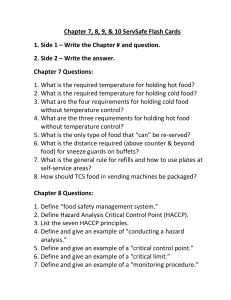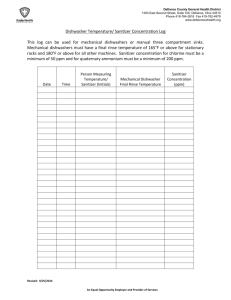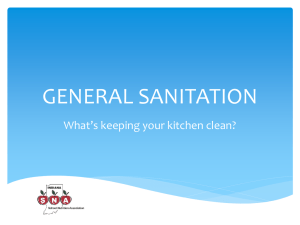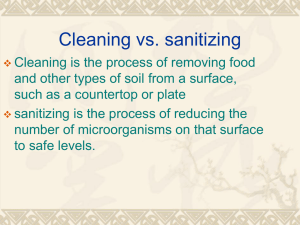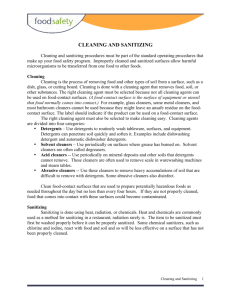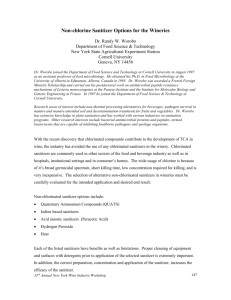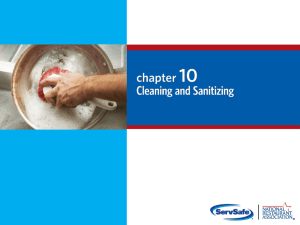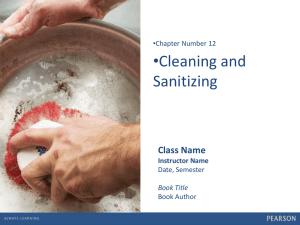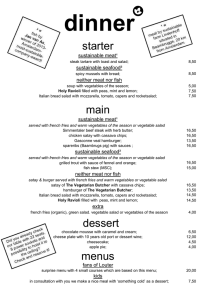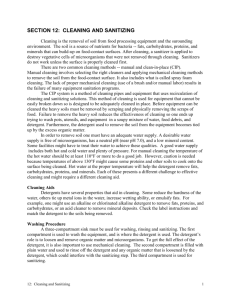Supervisor - Cooper County Public Health Center
advertisement
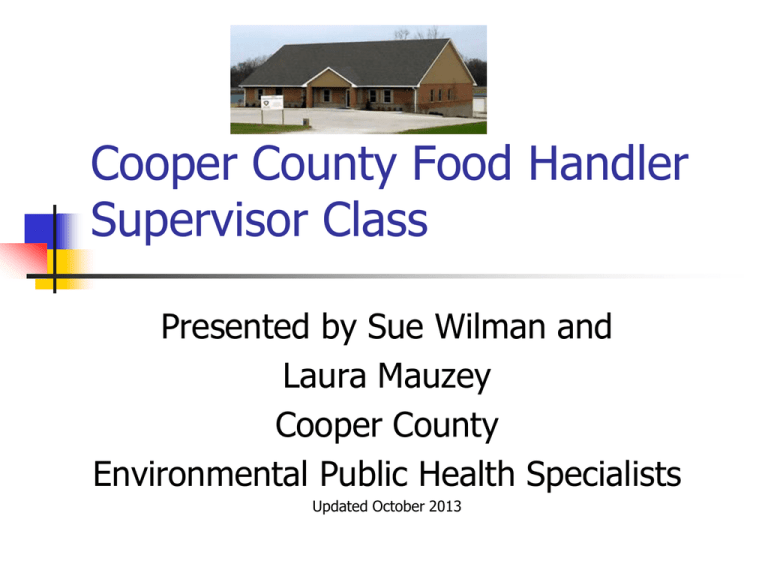
Cooper County Food Handler Supervisor Class Presented by Sue Wilman and Laura Mauzey Cooper County Environmental Public Health Specialists Updated October 2013 Starting Out With Food Safety Foodborne Illness Disease transferred to people by food Types of hazards Biological Physical Bacteria, viruses, fungi Hair, metal Chemical Cleaning/sanitizing agents Potentially Hazardous Foods Food that supports the growth of microorganisms Dairy products Eggs Meats, shellfish, poultry Raw seed sprouts Cut leafy greens Cut tomatoes or mixture of cut tomatoes Cut melons Garlic-in-oil mixtures How Food Becomes Unsafe Time and temperature abuse Cross-contamination Temperature danger zone Improper handling and storage of food Poor personal hygiene Improper handwashing Jewelry Smoking Keeping the Flow of Food Safe Receiving Storing Preparing Cooking Holding Serving Cooling Reheating Basics of Food Safety Keep things clean and sanitized Practice good personal hygiene Wash hands thoroughly and frequently Minimize the time food spends in the temperature danger zone Prevent cross-contamination Ensuring Proper Personal Hygiene How Employees Can Contaminate Food Failing to wash hands after using the restroom Touching hair, face, or body and then touching food Coughing or sneezing near food Touching or scratching a cut and then touching food Touching anything that can contaminate food Personal Cleanliness Practices Report illnesses Shower or bathe daily Bandage and cover any cuts or abrasions Clean and trim fingernails May wear nail polish and false fingernails if wearing gloves Leave all jewelry at home-except for a plain ring such as a wedding band Wear clean uniforms and aprons Avoid eating, drinking, or smoking on the job Wear hair and/or beard restraints when working with food When to Wash After using the restroom Before and after handling raw food After touching hair, face, or body After coughing and sneezing into your hand When switching from one task to another After handling chemicals Before and after changing gloves After busing tables After handling garbage Before and after your break After eating, drinking, or smoking Anytime you come in contact with anything that can contaminate food Where to Wash In a designated handwash sink Signage Hot water Soap Paper towels Trash can Never in a sink used for food prep or dish washing How to Wash Wet hands in hot running water Apply soap Rub hands together at least 20 seconds Clean under fingernails and between fingers Rinse under running water Dry hands Proper Glove Usage Gloves should not be used in place of handwashing Change gloves: When they are soiled or torn Before beginning a different task After handling raw meat and before handling cooked or ready-to-eat food Purchasing, Receiving, and Storing Purchasing Good, reliable supplier Safe food How to Calibrate a Thermometer Ice point method Fill large container with crushed ice. Fill with tap water. Stir well. Put thermometer stem into water until indicator stops moving. Hold calibration nut with wrench and turn thermometer head until it reads 32˚F. When to Accept or Reject a Delivery Check for: Damaged containers Temperature Color Texture Mandatory stamp How to Properly Store Food As quickly as possible Refrigerator storage Temperature should be 41˚F or lower Anything opened should be labeled and dated Store ready-to-eat foods above raw meats Dry storage Area should be clean, cool, and dry (50˚F to 70˚F) Shelves should be 6 inches from the wall and above the floor Date Labels Label ready-to-eat, potentially hazardous foods 7 days from preparation or opening for discard Except-the following foods prepared and packaged by an inspected food processing plant Deli Salads Ham salad Seafood salad Chicken salad Egg salad Pasta salad Potato salad Macaroni salad Some Cheeses Hard cheese: cheddar, gruyere, parmesan, reggiana, romano Semi-soft: blue, edam, gorgonzola, gouda, monterey jack Cultured dairy products: yogurt, sour cream, buttermilk See Missouri Food Code 3-501.17 for more information Storage FIFO First in, first out 6” off the floor **If the food isn’t safe when it comes into the establishment, there is nothing you can do to make it safe.** Preparing, Cooking, and Serving Key Practices Thawing Cooking Holding Serving Cooling Reheating Thawing Under refrigeration at 41˚F or lower Under running drinkable water at 70˚F or lower In a microwave if cooked immediately As part of the cooking process Preparing Prepare food in small batches Store prepared foods as quickly as possible Cooking Cook to the minimum internal temperature Poultry 165˚F Ground beef 155˚F Pork 145˚F Beef 145˚F Fish 145˚F Holding Hot holding Cold holding 135˚F or higher 41˚F or lower Check temperatures every 4 hours Temperature danger zone 41˚F to 135˚F Serving Buffets Sneeze guards Place to return utensils Labels Separate raw food from ready-to-eat food Cooling From 135˚F to 70˚F within 2 hours From 70˚F to 41˚F within 4 hours Methods of cooling Use smaller containers Ice water bath Ice paddles Add ice/cold water as an ingredient Never cool at room temperature Reheating To 165˚F for 15 seconds within 2 hours Cleaning and Sanitizing Cleaning vs. Sanitizing Cleaning Sanitizing Decreases the number of microorganisms All food contact surfaces must be cleaned and sanitized Removes food debris After every use When beginning work with another type of food Clean and sanitize equipment every 4 hours Sanitizers Heat Dishwashers Water temperature at or above 171˚F Chemicals Chlorine Iodine Quaternary ammonium compounds (quats) Sanitizers Test strips Specific for the sanitizer Test for correct concentration Wiping cloths kept in sanitizer Store all chemicals away from food Sanitizer Effectiveness Dependent upon: Temperature of the water Time sanitizer is in contact with the item Concentration of the sanitizer Manual Dishwashing Clean area 3 compartment sink Wash/rinse/sanitize Air dry Dishwashing Machines Detergent and sanitizer levels-warewashing machines installed after January 2000 must have a visual or audible alarm to signal if the detergents and sanitizers are not delivered. Water temperature and pressure All set to manufacturer recommendation Clean machine Use acid cleaner to remove scale Don’t overload dish racks Storing Clean Items Everything must be 6 inches off the floor Drawers and shelves must be cleaned and sanitized Clean equipment and utensils stored covered or inverted Silverware and utensils stored with handles up Storing Cleaning Supplies Away from all food, clean equipment and clean dishware All cleaning solutions not stored in their original containers must be labeled
